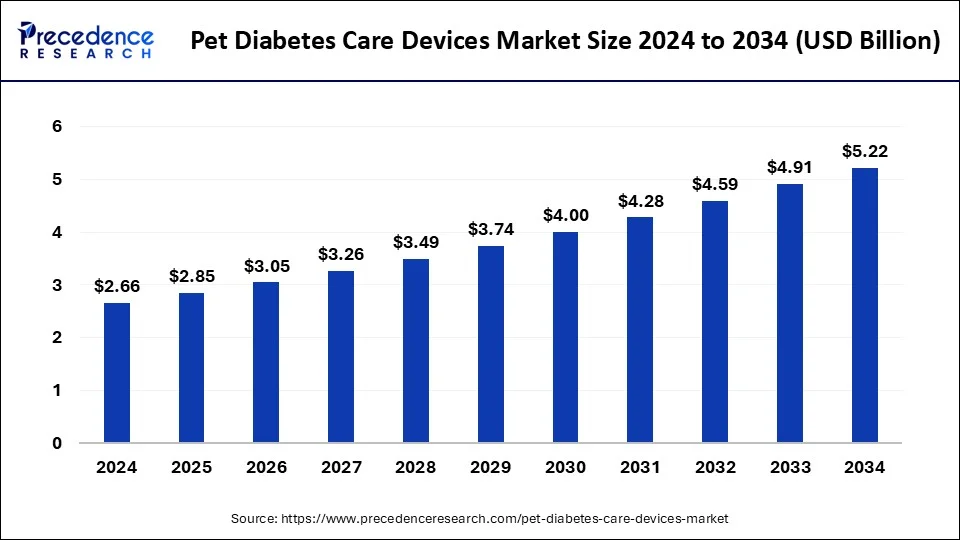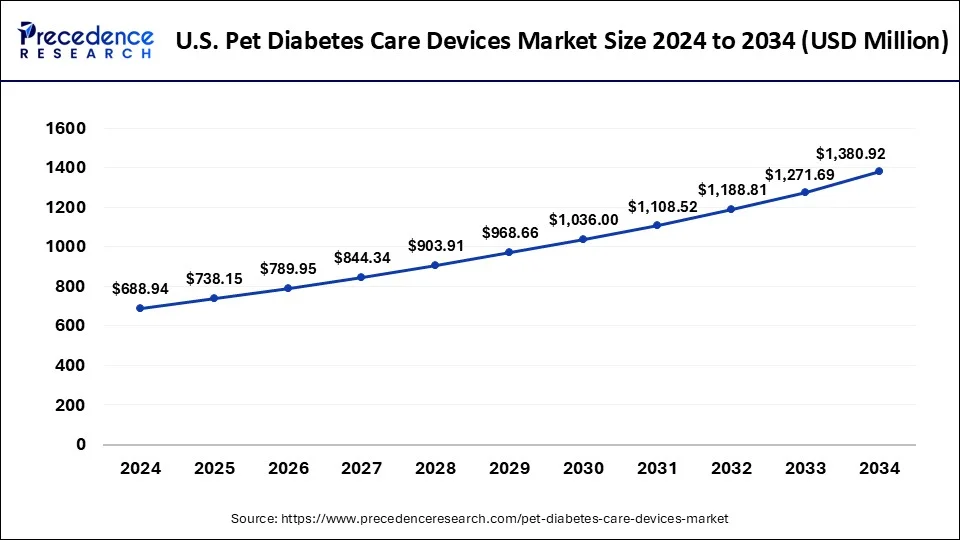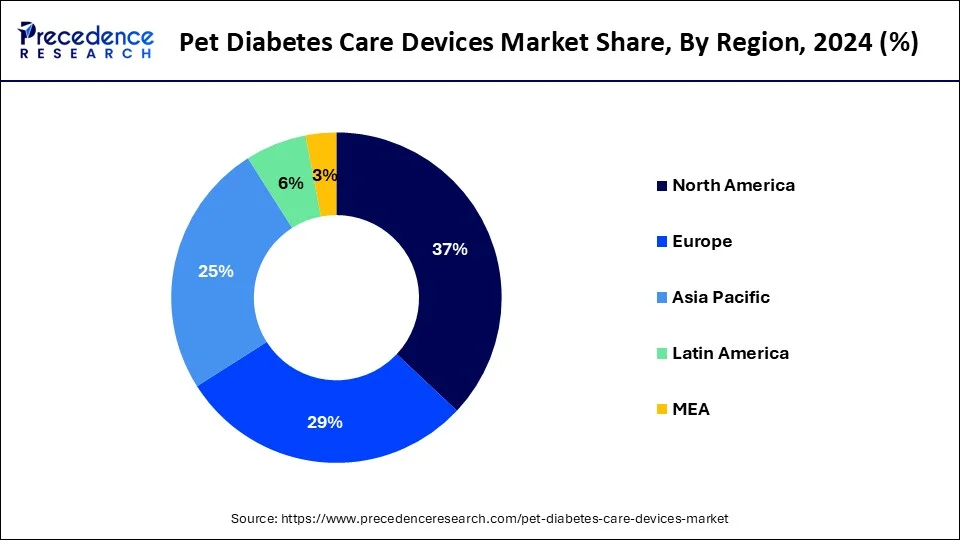September 2024
The global pet diabetes care devices market size accounted for USD 2.85 billion in 2025 and is forecasted to hit around USD 5.22 billion by 2034, representing a CAGR of 6.97% from 2025 to 2034. The North America market size was estimated at USD 980 million in 2024 and is expanding at a CAGR of 7.18% during the forecast period. The market sizing and forecasts are revenue-based (USD Million/Billion), with 2024 as the base year.
The global pet diabetes care devices market size accounted for USD 2.66 billion in 2024 and is predicted to increase from USD 2.85 billion in 2025 to approximately USD 5.22 billion by 2034, expanding at a CAGR of 6.97% from 2025 to 2034.

The U.S. pet diabetes care devices market size was exhibited at USD 688.94 million in 2024 and is projected to be worth around USD 1,380.92 million by 2034, growing at a CAGR of 7.25% from 2025 to 2034.

North America held the dominating the largest pet diabetes care devices market share of 37% in 2024. The United States, being the largest contributor of the market in the region is observed to sustain the position throughout the forecast period. The region’s dominance and rapid growth is due to the increasing number of pet owners, awareness regarding pet health, and government initiatives. The region has comparatively high and advanced veterinary sectors, such as clinics and hospitals for pet care, specialized professions, and doctors.

The Asia-Pacific region holds the title of the fastest-growing region in the pet diabetes care devices market for the forecast period. The rapid surge in business activities in pet care sector acts as a major driver for the market. Various startups for pet care have been established in the region, including an extensive array of products and services, encompassing nutrition, healthcare, and training, to establish an ultimate pet care ecosystem in the country.
Major manufacturers and distributors of pet diabetes care devices are expanding their presence in the Asia Pacific region, either through direct sales channels or partnerships with local distributors. This increased market penetration enhances the availability and accessibility of diabetes care devices, further driving market growth. As pet owners in Asia Pacific become more affluent, they are willing to invest in advanced healthcare services and products for their pets. This includes the purchase of diabetes care devices that offer convenience, accuracy, and ease of use in managing their pets' diabetes.
Diabetes is relatively common in dogs and cats. Pets with diabetes require extra care and lifelong treatment, including special diets, good fitness regimens, monitoring devices, regular insulin injections, and proper veterinarian checkups. The treatment varies from one pet to another. Also, it is essential to check pets' blood and urine sugar levels regularly. Apart from veterinarian visits, regular examinations and testing using home monitoring devices are best for checking blood and urine glucose levels. The advanced devices detect pet healthcare by monitoring health status and managing health issues in order to prevent severe complications.
The pet diabetes care devices market offers essential tools and devices for managing health conditions. These devices come in different shapes and sizes and include glucose monitoring systems, insulin pens and glucose meters. Veterinary clinics play a crucial role in promoting these devices and uplifting the global market during the forecast period.
Healthcare professionals and caretakers in veterinary clinics promote the use of pet diabetes care devices to better care for pets. These devices help pet owners diagnose pet conditions, and veterinarians provide guidance on how to use them effectively. Additionally, they can advise pet owners on providing better nutrition and monitoring their pet's blood glucose. The growing awareness of pet health and well-being has created an increased need for cutting-edge diabetic care equipment to monitor and manage the health and quality of life of companion animals with diabetes.
| Report Coverage | Details |
| Growth Rate from 2025 to 2034 | CAGR of 6.97% |
| Market Size in 2025 | USD 2.85 Billion |
| Market Size by 2034 | USD 5.22 Billion |
| Base Year | 2024 |
| Forecast Period | 2025 to 2034 |
| Segments Covered | By Device, By Animal, and By End-use |
| Regions Covered | North America, Europe, Asia-Pacific, Latin America, and Middle East & Africa |
Rising pet population
The pet population is rapidly increasing worldwide, which is leading to a higher demand for diabetes care devices for pets. This factor is observed to act as a major driver for the pet diabetes care devices market.
As the pet population grows, so does the prevalence of diabetes among companion animals. Factors such as aging pets, obesity, genetic predisposition, and changes in lifestyle contribute to the rising incidence of diabetes in pets, necessitating the use of specialized diabetes care devices for management and treatment. Pet owners are increasingly prioritizing the health and wellbeing of their pets, leading to greater investments in preventive and therapeutic healthcare measures. As diabetes can significantly impact the quality of life and longevity of pets, pet owners are more inclined to invest in diabetes care devices to ensure optimal management of the condition.
Promotion of diabetes care devices by veterinarians
Healthcare professionals and animal caretakers at veterinary clinics are advocating for the use of pet diabetes care devices to improve the care of pets. These devices allow for easy monitoring of blood glucose levels in pets without causing any stress or requiring significant effort. Additionally, the use of diabetes devices can help pet owners avoid the need for frequent visits to hospitals and clinics.
Lack of awareness regarding diabetes care devices for pets
Consumers, businesses, and policymakers may impede market growth by not fully appreciating the benefits and potential of pet diabetes care devices. Thus, the factors acts as a major restraint for the pet diabetes care devices market. Pet owners may not realize the availability of specialized diabetes care devices for pets, such as glucose monitoring systems, insulin pumps, and insulin pens. Without awareness of these treatment options, pet owners may not seek appropriate care for their diabetic pets or may rely solely on traditional treatment methods. There may be a stigma associated with pet diabetes, leading to reluctance among pet owners to acknowledge or address their pet's condition. This stigma can contribute to a lack of awareness and understanding of diabetes care devices for pets, further hindering market growth.
Advanced technologies for measuring blood glucose levels in pets
Traditionally, veterinarians have used a technique called glucose curves to measure blood sugar levels in pets. This method involves taking blood samples over a period of more than 12 hours and plotting the findings manually. However, this method is not very accurate in providing typical glucose levels due to situations that cause anxiety in pets, such as going to the vet, which can skew blood sugar levels. Additionally, the process is labour-intensive.
The small medical sensors known as continuous glucose monitors (CGMs) were developed to monitor blood glucose levels in humans with diabetes. Now, veterinarians are using these devices to monitor diabetes in pets as well. CGMs are less stressful for pets and less expensive than traditional monitoring methods. This technology also helps regulate diabetes in pets with proper medications. Thereby, the factor is observed to act as an opportunity for the expansion of the pet diabetes care devices market.
The pet diabetes care devices market is classified into glucose monitoring devices and insulin delivery devices. Out of these two the insulin delivery devices segment dominated the global market. With the increasing incidence of diabetes mellitus in pets, there is a rising demand for effective management solutions. Insulin delivery devices play a crucial role in administering insulin therapy, which is the primary treatment for diabetic pets.
Insulin delivery devices are designed to be user-friendly, allowing pet owners to administer insulin injections safely and effectively at home. This ease of use is essential for ensuring compliance with treatment regimens and maintaining optimal blood glucose levels in diabetic pets.
The dogs segment dominated the pet diabetes care devices market with the largest share in 2024. Diagnosing diabetes in dogs can be relatively straightforward compared to other pets, as dogs often exhibit classic symptoms such as increased thirst, frequent urination, weight loss, and lethargy. Veterinary professionals routinely screen dogs for diabetes during wellness exams, leading to earlier diagnosis and intervention. Dogs are valued members of many households and are often considered part of the family. Pet owners are highly motivated to provide the best possible care for their canine companions, including investing in advanced medical technologies and treatments to manage chronic conditions like diabetes.
The veterinary hospitals segment led the pet diabetes care devices market in 2023, the segment is observed to sustain the dominance throughout the forecast period. Veterinary hospitals are equipped with trained veterinarians and staff who specialize in diagnosing and treating pet diseases, including diabetes. They have the expertise to properly manage diabetes in pets and recommend appropriate treatment options, including the use of diabetes care devices. Veterinary hospitals have access to a wide range of advanced treatment options for managing diabetes in pets, including insulin therapy, dietary management, and exercise programs. They may also offer alternative therapies such as continuous glucose monitoring (CGM) systems and insulin pumps.
The home care settings segment is observed to witness a significant rate of growth in the pet diabetes care devices market during the forecast period. Home care settings enable pet owners to monitor their pet's blood glucose levels regularly, facilitating early detection of fluctuations and prompt intervention as needed. This continuous monitoring helps in maintaining tight glycemic control and preventing complications associated with diabetes. Home care settings can be more cost-effective for pet owners compared to frequent visits to veterinary clinics for diabetes management. While there may be initial investments in diabetes care devices and supplies, the long-term savings from reduced veterinary expenses can be significant.
By Device
By Animal
By End-use
By Geography
For inquiries regarding discounts, bulk purchases, or customization requests, please contact us at sales@precedenceresearch.com
No cookie-cutter, only authentic analysis – take the 1st step to become a Precedence Research client
September 2024
March 2025
January 2025
January 2025